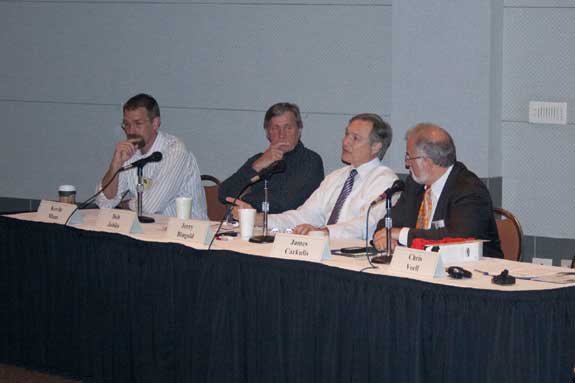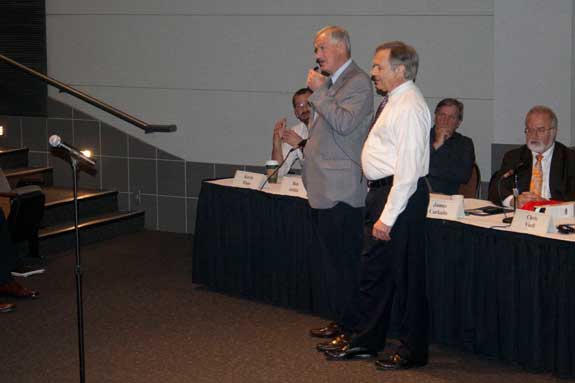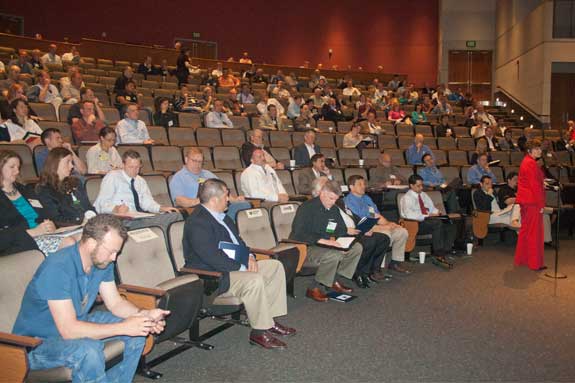TRENDING TOPIC ARTICLE: MANURE Published: May 31, 2011 This article highlighted the AgSTAR National Conference in Boise, Idaho, in 2011, where Innovation Center for U.S. Dairy's Jerry Bingold announced a goal of 1,300 anaerobic digesters to be built by the year 2020. This would mean a digester built every day for four years. to jump to the article. Click here to learn about a new report being developed by the Innovation Center for U.S. Dairy. Bingold explains the development of digesters and why the 1,300 number may no longer be necessary.
ARTICLE

An anaerobic digester built every day for the next four years. This statement set the stage for the Sixth Annual AgSTAR National Conference held in Boise, Idaho, in early May.
A digester a day for four years adds up to a total of 1,300, the goal for biogas recovery or anaerobic digester systems expected to be built in the U.S. by 2020.
James Carkulis, President and CEO of Exergy Development Group , set the tone for the entire conference as he discussed where the U.S. stood today and what it would take to keep the digester industry moving forward.
Carkulis noted that a very strong and willing dairy, interested in participating, would be needed for manure-based digester systems to work. He also pointed out that the right technology, backed by performance that was well-documented, would be needed in all cases.
“I think it’s imperative to find the right solutions,” Carkulis said. “The technology, the contracts, the performance and the operations must all align.”
Carkulis noted that the industry had a long way to go, as only 116 digesters had been reported at the end of 2010, yet there were 8,241 prime candidates for manure-based digesters across the country. He compared the U.S. to Germany, pointing out that Germany currently had 5,000 anaerobic digesters, of which 500 were manure-based.
Carkulis’ comments led to the topics that would be discussed throughout the conference, the most important being profitability from these systems across the industry.
“You have to find a way to make revenue out of all of this because at the end of the day, if it’s a wash or if you’re losing money, it’s not going to happen.” Carkulis said.

Innovation Center for U.S. Dairy announcement
Speakers from different areas of the digester industry led the panel discussions throughout the conference. Jerry Bingold, Renewable Energy Director for the Innovation Center for U.S. Dairy , began the first panel discussion by reiterating the 2020 digester system goal.
“1,300 digesters between now and 2020; that’s my job, I’ve got to do that,” Bingold said. “I can’t do it alone though.”
Bingold stated that 1,300 digesters would require help from all those involved in the industry and would require working alongside developers and electric cooperatives. He also indicated the development of mixed projects which could integrate solar, digester and wind projects.
Bingold commented that the digester industry needed to be developed in order to construct the 1,300 digesters, and financing was one of the top priorities that would determine if this would happen. He said that there were many opportunities available that would make reaching this goal possible, including the use of technology now available which utilizes the liquid effluent from digester operations and creates plastics from it. He indicated that the revenue stream from this type of technology could be unprecedented, in terms of its use on digester operations.
Dennis Keiser from the engineering management program at the University of Idaho – Idaho Falls joined Bingold to make a special announcement about a partnership which had been established to develop a national research program focusing on enhancing the economic viability of dairy farms and rural communities.
“I’m very proud to announce the dairy industry best practices memorandum of understanding has been signed by the Innovation Center for Dairy, the Center for Advanced Energy Studies , the Idaho National Laboratory , together with the U.S. Department of Energy to promote dairy best practices in manure management across the U.S.”
Story continues below video.
Funding sources
One of the main concerns that resonated throughout the conference was the funding of digester projects, a factor that would ultimately determine the future of digester systems. The funding sources that were discussed included USDA grant and loan guarantee programs, as well as carbon credits from the Climate Action Reserve .
Chris Cassidy with USDA Rural Development explained that an interim rule had been published for the USDA’s REAP (Rural Energy for America Program) program, which would modify the existing grant and guaranteed loan program for renewable energy systems and energy efficiency improvements. Cassidy pointed out that the REAP program would be in a comment period until June and invited the audience to submit comments, as it would be the best opportunity to receive input from the industry.
Max DuBuisson, policy manager at the Climate Action Reserve, discussed the possibility of how digester projects could benefit from carbon credits.
A key piece of advice given by presenters in regards to financing digester projects was to anticipate what lenders want. Bob Joblin with the Ag Power Group explained that it was very essential to have off-take agreements established with the dairy. Having the right technology and being able to prove that it would work were among other pieces of advice.

Other presenters discussed that, in order to ensure the future of the digester industry, it was vital to drive the risk out of digesters. Kevin Maas with Farm Power Northwest ensured that success was possible in various ways, including establishing multi-farm projects or finding a utility company beforehand that was interested in purchasing energy from the biogas recovery system.
Successful digester systems
Allison Costa, Program Manager for AgSTAR, presented information based on a survey which highlighted why established digester projects across the country had failed in the past and how to avoid those failures in the future. Costa noted that the digester industry has had an overall 14 percent failure rate since 1998.
According to the survey findings, key factors that would cause a system to shut down included having a system operated by an unskilled person that had little to no understanding of the digester system process or its place on the farm system, using inadequate equipment such as chopper pumps and not having a backup system in place. The results indicated that successful digester systems have an effective digester system design, a complete business plan and established operations and maintenance contracts. PD
AgSTAR is a voluntary outreach and educational program that promotes the recovery and use of methane from animal manure and was developed as a collaborative effort between the EPA, the U.S. Department of Agriculture and the U.S. Department of Energy. To learn more about AgSTAR, visit http://www.epa.gov/agstar/ .






